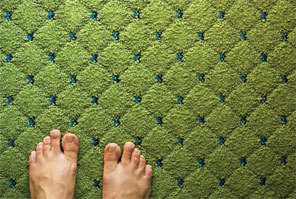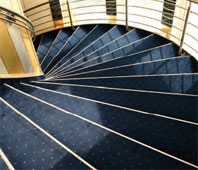What Makes Carpet Green?
 According to former U.S. Surgeon General Richard H. Carmona, in the past 25 years the percentage of indoor air quality health evaluations conducted by the Centers for Disease Control (CDC) has increased from 0.5 percent to 52 percent. Restated, indoor air quality evaluations have increased from one in every 200 to one in every two. While these are startling, they correlate directly to Admiral Carmona’s study on indoor air quality in non-industrial structures – meaning, in workplaces, schools, offices, houses, apartment buildings and vehicles. According to his January 2005 ground-breaking report, Americans spend an astonishing 85 to 95 percent of their time indoors.
According to former U.S. Surgeon General Richard H. Carmona, in the past 25 years the percentage of indoor air quality health evaluations conducted by the Centers for Disease Control (CDC) has increased from 0.5 percent to 52 percent. Restated, indoor air quality evaluations have increased from one in every 200 to one in every two. While these are startling, they correlate directly to Admiral Carmona’s study on indoor air quality in non-industrial structures – meaning, in workplaces, schools, offices, houses, apartment buildings and vehicles. According to his January 2005 ground-breaking report, Americans spend an astonishing 85 to 95 percent of their time indoors.
This is a significant lifestyle change from earlier generations’ making indoor air quality not only a hot topic but also one of this country’s greatest health concerns. According to Carmona, the rate of asthma in young children has correspondingly risen by 160 percent in the past 15 years, and today one out of every 13 school-aged children has asthma. Carmona stressed that, “while we need to be cognizant and concerned about our outdoor environment, including pollution and smog, we must put at least equal emphasis on the long-overlooked issue of indoor environments.”
Because carpet covers almost 70 percent of U.S. floors, it is important to dissect its impact on America, especially given the perceived health threats. During the “killer carpet” scare in the early ’90s, people were hesitant to invest in carpet because they were uncertain about its potential effect in their homes. A common myth was that carpet contained the volatile organic compound (VOC) formaldehyde; but, according to Frank K. Hurd, vice president and chief operating officer of the Carpet and Rug Institute (CRI), formaldehyde has not been put in carpet for more than 20 years.

© iStockphoto.com/eurobanks
VOCs are chemicals used to manufacture and to prepare many building materials, interior furnishings, textiles, office equipment, cleaners, personal care supplies and pesticides. According to the U.S. Environmental Protection Agency (EPA), VOCs are common in the indoor environment, and their levels may be ten to thousands of times higher indoors than outdoors. A single indoor air sample may contain anywhere from 50 to up to hundreds of individual VOCs – irritants resulting in headaches; eye, nose and throat irritation; and dizziness, to name a few known complications.
VOCs are coined “volatile” because their chemicals can evaporate at room temperature and escape into the air. “Off-gassing” is what instigated carpet paranoia in the early ’90s. However, according to Hurd, “as a general rule, off-gassing is a non-issue. Within 30 days no off-gassing occurs in carpet. Tables and chairs in your office put off more off-gassing than the carpet.” In fact, carpet is actually the lowest VOC emitter among indoor products such as paint, floor adhesive, floor wax, wall covering and sheet vinyl.
Another very common misconception is that carpet contributes to asthma and to allergies among adults and children alike. However, no scientific study links the rise of allergy and asthma cases to carpet use. In fact, research reports have illustrated just the opposite. A 15-year Swedish study discovered no link between carpet usage and incidences of allergy or asthma. Surprisingly enough, when carpet usage in Sweden decreased by 70 percent, allergy reactions among the general population actually increased 30 percent. Another major analysis was conducted on behalf of the European Community Health Survey and involved 19,218 subjects from 38 health centers across 18 different countries, including the United States. The data was consistent in that it showed fitted carpets in bedrooms were related to fewer asthma symptoms and less bronchial responsiveness. The results were even more pronounced among dust-mite sensitized individuals.

© iStockphoto.com/Brasil2
Despite what your mother may have told you, carpet actually traps allergens and acts as a filter. Studies have measured the distribution of airborne dust associated with normal activities on smooth surfaces and on carpeted floors. Findings point out that walking on hard surfaces disturbs more particles, which become airborne and enter the breathing zone. In contrast, carpeted surfaces trap more particles so that walking disturbs fewer of them and results in fewer particles in the breathing zone.
In response to concern over VOCs and other health impacts, the Carpet and Rug Institute has implemented programs to prove carpet free of potentially harmful chemical levels. According to Werner Braun, president of the Carpet and Rug Institute, “CRI came up with a Green Label Program in 1992 as a voluntary response to indoor air quality issues. Since its inception the Green Label Program has voluntarily lowered its standard four times, and carpet has become not only the lowest emitter of VOCs among floor coverings but one of the lowest-emitting VOC products in the home and in the office. Just recently a new Green Label Plus was unveiled; it not only tests for more chemicals but has instituted a lower threshold for the commercial environment. This independent monitoring program for carpet meets, and even exceeds, California’s indoor environmental quality standards for low-emitting products. A similar effort was also launched to upgrade the Green Label program for adhesives.”
Sustainability considerations, such as product life extension, recycling and contribution to energy efficiency, come into play when evaluating the “greenness” of carpet. Thanks to technology, today’s carpet is more stain-and soil resistant than ever before; but industry surveys show that carpets have been removed and replaced prematurely simply because they “uglied out.” Upon testing, CRI discovered that many cleaning products not only did a poor job of removing soils and stains; they actually made the problem worse by leaving behind detergents that attracted dirt to the product. CRI’s Seal of Approval (SOA) testing program concluded that only four of 25 products initially tested cleaned better than water.
Braun elaborates, “The SOA testing program was eventually expanded to include tests of deep-cleaning extractors to insure they performed up to standard and to give the consumer valuable information he or she needed to make sure his or her investment is being protected. The SOA program has since added vacuum cleaners to it and has been a resounding success in identifying products that work. Again, all this goes a long way in reducing the environmental footprint of carpet by keeping it on the floor through its useful life.”
While the cleaning and upkeep of carpet is imperative, it is obvious that no carpet will last forever. Currently, 4.7 billion pounds of carpet are annually disposed of in landfills and that number will only rise. In laymen’s terms, that figure equates to 13 trillion BTUs – enough energy to power 106,000 homes annually or to produce 108 million gallons of gas per year – enough to drive 2.7 billion miles annually. To tackle this challenge, the carpet industry signed an historic agreement with state and federal governments to achieve 40 percent landfill diversion by the year 2012. From this agreement, the Carpet America Recovery Effort (CARE) was established as a 501c3 non-profit organization to act as a facilitator, advisor, information provider and forum for a myriad of stakeholders to facilitate progress toward CARE’s mission. That goal, Braun simply states, “is to develop market-based solutions for the recycling and reuse of post-consumer carpet.”
Efforts are underway nationally to increase the options for recycling waste carpet as well as to use components containing post-consumer carpet content to make new carpet. A number of options exist for managing carpet waste: direct reuse, refurbishment, recycling carpet backing into new carpet backing and “carpet to carpet” recycling. However, in no way can all carpet material be used for new carpet so considerable effort is being focused upon non-carpet products containing post-consumer and post-industrial materials derived from recycled carpet such as nylon boards, roof shingles, composite railroad ties and marine timbers, among other items.
Another important sustainability factor that makes carpet “green” is its ability to reduce home energy consumption when used. Today’s consumer is increasingly aware of a product’s energy efficiency value. America’s residential sector currently devours approximately 12 percent of the nation’s total annual energy consumption for space heating and air conditioning. A thermal study on carpet indicated that a carpet-pad combination reduced heat loss by as much as 54 percent when installed on a non-insulated wood floor over a ventilated crawl space and by as much as 72 percent when installed on a non-insulated, exposed-edge concrete slab on grade. Those numbers equate to as much as a 15 percent savings on an annual heating bill.
Another of the carpet industry’s latest innovations has been introduction of the Sustainable Carpet Assessment Standard or NSF 140. “Architects, designers and end users will now have one standard to identify carpets that have a reduced environmental impact. The first multi-attribute American National Standards Institute (ANSI) approved Standard – NSF 140-2007, Sustainable Carpet Assessment Standard for environmentally preferable building materials – introduced at the U.S. Green Building Council’s November Greenbuild 2007 conference and exhibition in Chicago. The unified Standard for sustainable carpet is voluntary, inclusive and based on life cycle assessment (LCA) principles. The first carpet products certified to the approved Standard are expected to be available in the marketplace by the second quarter of 2008. The NSF mark will appear on the packaging of certified products to demonstrate compliance,” explained Braun. For more information on the NSF 140-2007, Sustainable Carpet Assessment Standard, please visit www.nsf.org/info/carpet.
Not only is carpet green and sustainable, but it offers a unique way to decorate commercial and residential buildings. Carpet comes in a variety of interesting colors, styles and textures, all of which can add great accent to any room. Carpet also enhances room acoustics and makes it easier to converse with friends or to listen to the TV. With the aging of the baby boomers it is important to note that carpet provides soft surfaces as well as great slip and fall prevention. Carpet offers overwhelming advantages in health, finance and style. Having the right products and a proactive stance on carpet maintenance, anyone can help keep carpet green by giving it a long, full life.
Braun concurs, “Carpet has many wonderful and useful benefits, from its warmth and comfort underfoot to its ability to trap allergens and to keep them out of the breathing zone in an effort to improve indoor air quality. Its ease of maintenance and the cost savings involved in comparison to other flooring options, as well as the safety from slips and falls are all documented benefits.”
In addition, Braun restates the carpet industry’s commitment to being green and sustainable by saying, “the carpet industry understands that no industry can sustain itself at the expense of our environment, our societies or our people. We are all in this world together and our products should reflect our commitment to the balance between environmental, social and economic contributions of the industry.”
Consumers and professionals alike can find extensive information about carpet selection, installation, maintenance, products and indoor air quality by visiting CRI’s websites (carpet-rug.org, www.carpet-health.org, and carpetrecovery.org) or by calling (706-278-3176).




























